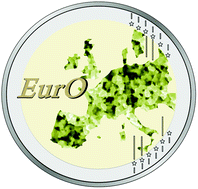EurOgels: A ferromagnetic semiconductor with a porous structure prepared via the assembly of hybrid nanorods†
Abstract
EuO is unique, because it belongs to the few solids combining semiconducting properties (Egap = 1.1 eV) with native ferromagnetism. For future applications of EuO, e.g. as spin-filters or for sensors, one has to learn how defined nanostructures can be prepared. Unlike other ceramic oxides, there are no established soft-chemistry routes (e.g. sol–gel) towards EuO nanomaterials e.g. porous materials. This is due to the labile nature of the oxidation state Eu(+II). We present a particle-based method leading to a EuO aerogel. Instead of making the target material directly, we use nanoparticles of an organic–inorganic hybrid phase (Eu2O3–benzoate) and assemble those into an aerogel, followed by the transformation into phase-pure EuO. It is shown that organic aldehydes act as capping agents for controlling the morphogenesis of the hybrid particles. Depending on the steric demand of the aldehyde, one obtains plate-like particles or nanorods with increasing aspect ratio. The particles form a gel, when the aspect ratio is increased to >20. After supercritical drying, one receives a nanorod-based aerogel. Treatment of the latter with Eu-vapor leads to reduction of the Eu2O3 domains to EuO while retaining the aerogel structure. Proof of ferromagnetism in the resulting EuO aerogel was delivered by SQUID measurements.



 Please wait while we load your content...
Please wait while we load your content...